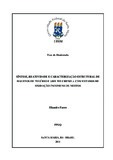| dc.creator | Faoro, Eliandro | |
| dc.date.accessioned | 2017-05-15 | |
| dc.date.available | 2017-05-15 | |
| dc.date.issued | 2011-03-24 | |
| dc.identifier.citation | FAORO, Eliandro. Synthesis, reactivity and structural characterization of tellurium and aryltellurenyl halides with unusual or mixed oxidation states.. 2011. 240 f. Tese (Doutorado em Química) - Universidade Federal de Santa Maria, Santa Maria, 2011. | por |
| dc.identifier.uri | http://repositorio.ufsm.br/handle/1/4209 | |
| dc.description.abstract | This work presents a study related to the halogenation of diarylditellurides (RTe)2
in order to obtain tellurium and aryltellurenyl halides with unusual or mixed oxidation
states. Although regarded as essentially unstable, the aryltellurenyl monohalides (RTeX)
were generated in situ and captured from the reaction milieu in many ways, forming
stable adducts or intermediates for the synthesis of new tellurium derivatives.
Overall, the twenty-one compounds presented in this paper can be summarized
into five distinct classes: {(Q+)n[RTeI2]−(I3)−
n-1}; {(RTeI3)(RTeI)n, n = 1,2};
{R2Te-Te(I)R}; {RTe Te(X2)R, X = Cl, Br and I} and {(Q+)2[Te2I10]2−}. The
determining factor for the formation of the first four classes is the nature of the organic
group (R) of the starting ditelluride. However, all of these compounds are subjected to
decomposition, inasmuch the bond C Te has the lowest energy among the carbon
chalcogen bonds, and this feature also contributes to the formation of the fifth class, the
tellurium halides {(Q+)2[Te2I10]2−}.
Structurally, these compounds were characterized by single crystal x-ray
diffraction, which showed the presence of intra- or intermolecular secondary bonds
Te···Te, Te···O, Te···X, X···X (X = halogen), interactions Te···p aryl, beyond hydrogen
bonds N H···X, responsible for the organization of supramolecular assemblies in the
solid state. | eng |
| dc.description.sponsorship | Conselho Nacional de Desenvolvimento Científico e Tecnológico | |
| dc.format | application/pdf | por |
| dc.language | por | por |
| dc.publisher | Universidade Federal de Santa Maria | por |
| dc.rights | Acesso Aberto | por |
| dc.subject | Haletos de ariltelurenila | por |
| dc.subject | Ligações secundárias | por |
| dc.subject | Difração de raios X | por |
| dc.subject | Aryltellurenyl halides | eng |
| dc.subject | Secondary bonds | eng |
| dc.subject | X-ray diffraction | eng |
| dc.title | Síntese, reatividade e caracterização estrutural de haletos de telúrio e ariltelurenila com estados de oxidação incomuns ou mistos. | por |
| dc.title.alternative | Synthesis, reactivity and structural characterization of tellurium and aryltellurenyl halides with unusual or mixed oxidation states. | eng |
| dc.type | Tese | por |
| dc.description.resumo | Este trabalho apresenta um estudo relacionado à halogenação de diarilditeluretos
(RTe)2 com o propósito de obter haletos de telúrio e ariltelurenila com estados de
oxidação incomuns ou mistos. Apesar de considerados essencialmente instáveis, os
mono-haletos de ariltelurenila (RTeX) foram gerados in situ e capturados do meio
reacional de diversas maneiras, formando desde adutos estáveis até intermediários para a
síntese de novos derivados de telúrio.
De maneira geral, os 21 compostos apresentados neste trabalho podem ser
resumidos em cinco classes distintas: {(Q+)n[RTeI2]−(I3)−
n-1}; {(RTeI3)(RTeI)n, n = 1,2};
{R2Te Te(I)R}, {RTe Te(X2)R, X = Cl, Br e I} e {(Q+)2[Te2I10]2−}. O fator determinante
para a formação das quatro primeiras classes é a natureza do grupamento orgânico (R) do
ditelureto de partida. Entretanto, todas estão sujeitas a reações de decomposição, visto
que a ligação C Te possui a menor energia dentre as ligações carbono calcogênio, o que
leva à formação da quinta classe, os haletos de telúrio {(Q+)2[Te2I10]2−}.
Estruturalmente esses compostos foram caracterizados por difração de raios X em
monocristal, o que demonstrou a presença de ligações secundárias intra- ou
intermoleculares Te···Te, Te···O, Te···X, X···X (X = halogênio), interações Te···areno-p,
além de ligações de hidrogênio N H···X, responsáveis pela organização das estruturas
supramoleculares no estado sólido. | por |
| dc.contributor.advisor1 | Oliveira, Gelson Noe Manzoni de | |
| dc.contributor.advisor1Lattes | http://lattes.cnpq.br/5103552511601104 | por |
| dc.contributor.referee1 | Drechsel, Sueli Maria | |
| dc.contributor.referee1Lattes | http://lattes.cnpq.br/0316254665452744 | por |
| dc.contributor.referee2 | Deflon, Victor Marcelo | |
| dc.contributor.referee2Lattes | http://lattes.cnpq.br/8068967021078220 | por |
| dc.contributor.referee3 | Back, Davi Fernando | |
| dc.contributor.referee3Lattes | http://lattes.cnpq.br/3778138554788107 | por |
| dc.contributor.referee4 | Lang, Ernesto Schulz | |
| dc.contributor.referee4Lattes | http://lattes.cnpq.br/4481982189769819 | por |
| dc.creator.Lattes | http://lattes.cnpq.br/2482924502296959 | por |
| dc.publisher.country | BR | por |
| dc.publisher.department | Química | por |
| dc.publisher.initials | UFSM | por |
| dc.publisher.program | Programa de Pós-Graduação em Química | por |
| dc.subject.cnpq | CNPQ::CIENCIAS EXATAS E DA TERRA::QUIMICA | por |


